Hotteok 호떡
Posted on: April 2, 2009
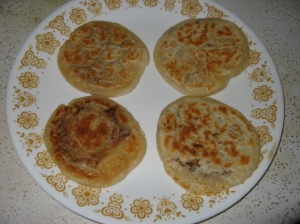
I think my fascination with Korean food began after I moved from the Bay Area to the East Coast for college. At the time my school, a private college in the New England area, ranked number 1 in student diversity in the region. Among that diversity was a very visible Korean student body, from South Korea as well as throughout the States. On the Foodies e-conference that we could access online, many students talked about the Korean markets and restaurants in the area. All this Korean food talk made me think, “I want!”
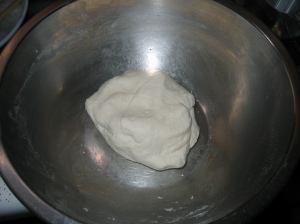
So I began my research on Korean cuisine — popular plates to order, everyday preparations, special occasion dishes, snacks, street eats, even down to proper Korean table manners (when I get into something, I really get into it). I had a fair share of Korean barbeque nights, got excited every time I went to a different Korean restaurant and had a new variety of ban chan (like appetizers at the beginning of a Korean meal), and even got as far as rolling and making my own kimbap (a Korean version of sushi usually eaten for lunch or prepared for picnics).
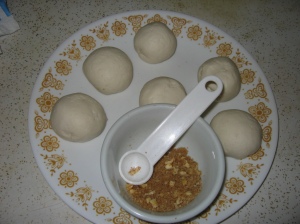
But among all of the dishes and snacks that really peaked my interest was a sweet Korean pancake called hotteok (pronounced “ho-duck”). I’d heard from college classmates and through food talk in the blogosphere that hotteok is a popular South Korean street snack, especially on cold winter nights. The pancakes are made of a mixture of all-purpose flour and glutinous rice flour with a rising agent, and then they’re filled with a brown sugar nut mixture. Once heated on a pan, they are golden brown, firm and chewy on the outside, dripping with molten brown sugar goo on the inside.
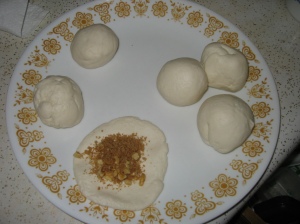
I tried finding them at a nearby Korean bakery when I’d heard of them, but the one I bought definitely wasn’t hot or fresh; hotteok is meant to be eaten HOT (the “ho” part of the name comes from the “ho!” sound that people make when their mouths are being scalded by the goo oozing out after taking their initial bite). So I figured the only way to get one was to make it myself. I had one before, though it wasn’t fresh, so I had an approximate idea of what it should taste like.
All the recipes I found in cookbooks and online were flawed in that they used all all-purpose flour. All-purpose flour would never be able to replicate the distinct chewiness that I knew hotteok had to have. Chewing a hotteok can be likened to chewing half a pancake (soft and light) and half a piece of Japanese mochi (chewy and slightly sticky from the pounded rice).
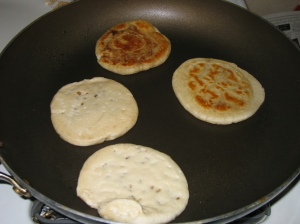
So I played with the proportions of the all-purpose flour and the glutinous rice flour, and decided that three parts all-purpose to two parts glutinous rice flour yielded the perfect balance of softness to chewiness. If you use too much all-purpose flour, the pancake won’t be chewy enough; if you use too much glutinous rice flour, eating the hotteok will be more like eating sticky rice than a pancake. In this pancake, balance is key.
Peanuts or walnuts are used as the nut filling for hotteok on the street in South Korea, but I have a personal preference for walnuts. They should be eaten as soon as they are taken off the griddle or frying pan, as this is when they taste the best and how they are usually eaten.
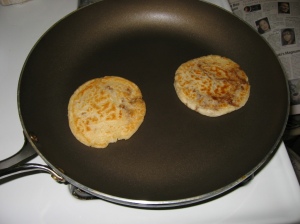
Hotteok 호떡 – Sweet Korean Pancakes
Yields 6 pancakes
Pancake:
- 3 teaspoons lukewarm water
- 1/4 teaspoon white sugar
- 1/4 teaspoon dry-active yeast
- 6 tablespoons milk
- 3/4 cup all-purpose flour
- 1/2 cup glutinous rice flour
- Pinch of salt
- Butter or canola oil
Filling:
- Scant 1/4 cup brown sugar
- 2-3 tablespoons walnuts, toasted and finely chopped
- 1/4 teaspoon ground cinnamon
Prepare the rising mixture by combining the water, sugar, and yeast in a medium sized mixing bowl. Allow it to sit and get bubbly for 10 minutes. Then add in the milk, all-purpose and glutinous rice flour, and salt. Mix well, then cover the bowl with plastic wrap and allow the dough to rise for about 3 hours.
Once the dough has about doubled in size, mix the brown sugar, cinnamon, and walnuts in a separate bowl. Butter a large frying pan and set it to medium heat.
After greasing your hands, take out the dough and knead it for one minute. Then separate the dough into six equal sized balls (they should be just slightly smaller than the size of your palm). Take one ball and flatten it with your hands, then place a generous spoonful of the cinnamon-sugar-nut mixture in the middle; pull the dough together to seal it and make a ball. Repeat with remaining five dough balls.
Place as many as can comfortably fit into the frying pan. Press them down with a greased spatula. After about 3-4 minutes, check the underside to see how done they are. When both sides are a golden brown shade and the cinnamon-sugar filling is almost leaking out, you will know they are done.
Serve hot as a snack or dessert with green or barley tea.
6 Responses to "Hotteok 호떡"
Great recipe and tips! Sorry if this is a bit late, and I dont mean to offend, bask or mentally hurt you in any way, but the chew from hotteok come from the kneading of the dough and the rising from the yeast, not glutinous rice flour.
I’ll try this recipe tonight, its different from all the other ones Ive seen 🙂 Newcomer to your blog and I love it 🙂
[…] as it would help with the thickness and the texture. So then I stumbled upon a recipe from I love butter and sugar that I thought turned out really […]
Thank you so much for posting this! My husband (who spent several years in Korea) and I have been searching for a good recipe that will produce Ho Duck’s with an authentic chewy texture. Just found this and we are SO glad!
Browsing digg.com I noticed your website bookmarked as:
Hotteok 호떡 � I love butter and sugar.. I am assuming you book-marked it yourself and
wanted to ask if social bookmarking gets you a ton of
targeted visitors? I’ve been thinking about doing some book-marking for a few of my websites but wasn’t certain if it would yield any positive results.
Appreciate it.
April 3, 2009 at 6:15 pm
Yummy! You should come down here and open Little rock’s first korean restaurant. I’m so happy you started a blog…keep writing!